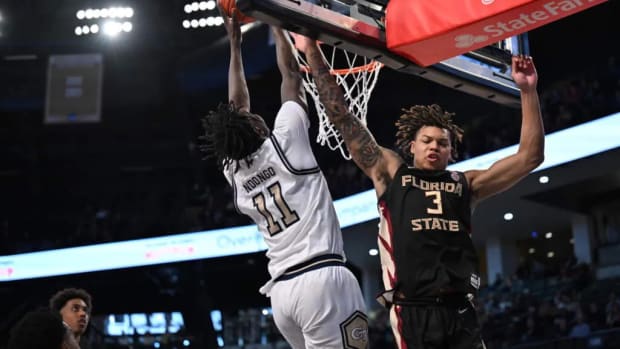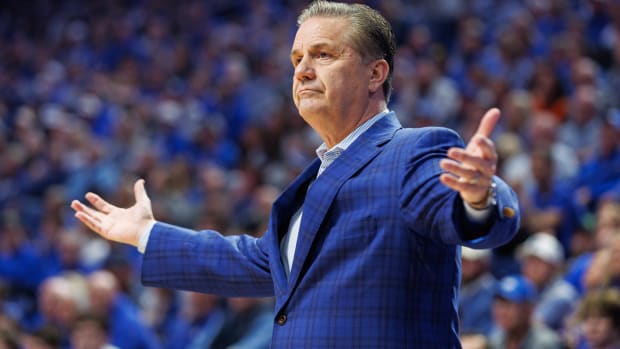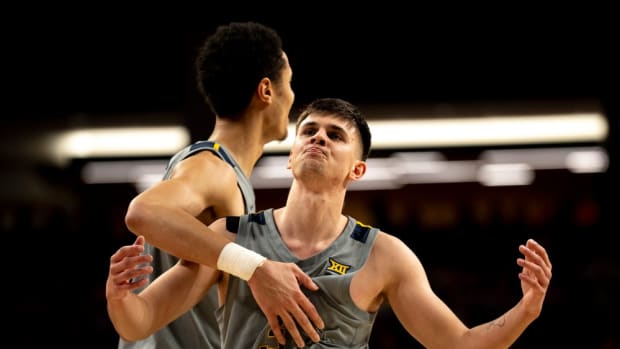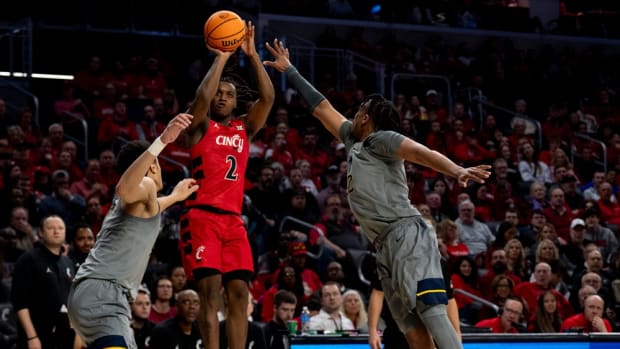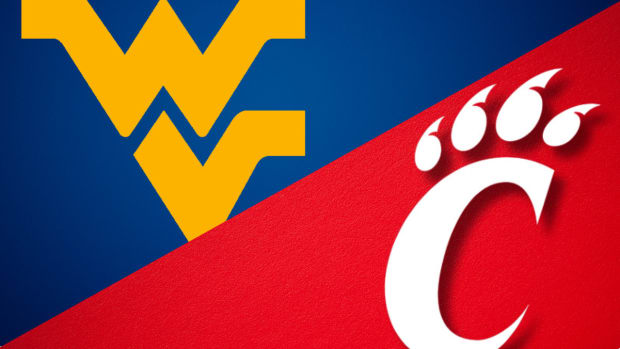Ranking the College Basketball National Champions of the Decade

To rank a decade’s worth of champions is to embark on a task of relativism and hair-splitting. Each of these 10 teams, after all, won a national championship, and to declare any of them “the worst” or even, say, seventh-best of 10 is to offer them a slight required by nothing but a context of one’s own making.
And yet, after games themselves, the sports world may have no greater tradition than theoretical, impossible-to-settle comparison. It is in that spirit and acknowledgement of the current decade’s closing that SI has sought to rank each of college basketball’s national champions from the 2010 postseason through the most recent one. Objective, per-possession analytics factored into this list as a starting point for comps between teams of varied styles from different seasons, but more subjective adjustments were made to emphasize late-season (and particularly in-tourney) performance and the team’s overall talent level (at the time, not in those players’ futures)—but no, one of them was not whether or not we hate your team.
How successful were those adjustments? Who knows. But without further ado, here is a ranking of the last 10 national champions with which you will surely agree.
More All-Decade Coverage: First Team | Second Team | Third Team
Record: 38–2
Adjusted efficiency margin*: +32.59 (1st nationally)
Adjusted offensive efficiency*: 122.2 (2nd nationally)
Adjusted defensive efficiency*: 89.6 (7th nationally)
Championship game starters: G Marquise Teague, G Doron Lamb, F Michael Kidd-Gilchrist, F Terrence Jones, F Anthony Davis
* per KenPom.com, here and throughout
While it did not enter the final weekend unblemished the way Kentucky’s 2015 team did, this Wildcats squad was closer to undefeated than you might remember, with its only losses coming on a December buzzer beater at Indiana (No. 9 in that season’s final KenPom rankings) and in an uncharacteristic collapse in the final minutes of the SEC title game against Vanderbilt (No. 16). Davis was the runaway player of the year, but it was this team’s balance and unselfish cohesion that made it truly special, with a team of five underclassman starters (aided by senior sixth man Darius Miller) playing beyond their years. Kentucky’s 2012 title put the common knocks on both coach John Calipari and teams built around one-and-done players to rest and in turn put the previous decade fully in the rearview, ushering in the 2010s in earnest.
Record: 36–4
Adjusted efficiency margin: +33.76 (1st nationally)
Adjusted offensive efficiency: 127.8 (1st nationally)
Adjusted defensive efficiency: 94.0 (11th nationally)
Championship game starters: G Jalen Brunson, G Phil Booth, F Mikal Bridges, F Eric Paschall, F Omari Spellman
Here was a team with so much depth that tournament MOP—and No. 17 overall pick in that June’s NBA draft—Donte DiVincenzo came off the bench. After a February slump, Jay Wright’s second title team rampaged through the NCAA tournament field, winning all six games by 12-plus points, four of those against top-12 teams in the season’s final KenPom overall efficiency rankings. The Wildcats were a picture of harmony peaking at the perfect time, with the national player of the year (Brunson) and an NBA lottery talent (Bridges) being flanked by two versatile vets (Booth and Paschall) and two underclassmen who played their way immediately into the draft’s first round (DiVincenzo and Spellman). For the tournament’s three weeks, they looked impossible to beat.
3. 2015 Duke
Record: 35–4
Adjusted efficiency margin: +32.48 (3rd nationally)
Adjusted offensive efficiency: 124.5 (3rd nationally)
Adjusted defensive efficiency: 92.0 (11th nationally)
Championship game starters: G Tyus Jones, G Matt Jones, G Quinn Cook, F Justise Winslow, C Jahlil Okafor
The decade’s best champs not named the Wildcats were also one of four champs not ranked No. 1 in season-long overall efficiency. But that measurement is a bit misleading with these youthful Blue Devils, who struggled on defense into the ACC season before adding an un-Krzyzewski-like zone to their repertoire. The result was a unit that actually posted the best raw defensive efficiency of any of the decade’s champions and in the title game managed to slow down Wisconsin, which finished that season with the most efficient offense of any team in the 18-season analytics era. Like Kentucky three years prior, this Duke team deftly blended one-and-done talent (Okafor, Winslow, Jones) with stable vets (Cook and top reserve Amile Jefferson). Whatever struggles Okafor may be having at the next level, he was an absolute force inside as a college freshman.
Record: 35–5
Adjusted efficiency margin: +32.92 (1st nationally)
Adjusted offensive efficiency: 117.7 (7th nationally)
Adjusted defensive efficiency: 84.8 (1st nationally)
Championship game starters: G Peyton Siva, G Russ Smith, F Wayne Blackshear, F Chane Behanan, C Gorgui Dieng
It’s likely the drama of reserve Kevin Ware’s gruesome compound leg fracture in the Elite Eight that first comes to mind for most, but these Cardinals’ swarming defense deserves its place in the collective memory too. Only two teams of the analytics era—last season’s Texas Tech team and 2015 Kentucky, both of which lost over the season’s final weekend—had a stingier defensive efficiency than the one that won coach Rick Pitino’s second (and since-vacated) national championship, thanks in large part to Siva and Smith’s backcourt pressure and Dieng’s shot-swatting anchoring inside. But the offense, as teams like Michigan and Duke found out in the tourney, could heat up quickly, especially when Smith and top reserve Luke Hancock were connecting from deep.
Record: 35–5
Adjusted efficiency margin: +32.01 (1st nationally)
Adjusted offensive efficiency: 122.8 (3rd nationally)
Adjusted defensive efficiency: 90.8 (5th nationally)
Championship game starters: G Ryan Arcidiacono, G Jalen Brunson, G Josh Hart, F Kris Jenkins, F Daniel Ochefu
After years of its own early-tourney disappointments, Villanova finally broke through and went all the way to claim Jay Wright’s first national title and the Wildcats’ second, after their underdog run in 1985. Like the championship team two years later, this Villanova squad went from really good to firing on all cylinders once the tournament began, including downright absurd offensive showings against Miami in the Sweet 16 (an offensive efficiency of 157.0 in a 92–69 win) and Oklahoma in the national semifinal (151.7 in a 95–51 win that set a Final Four record for largest margin of victory). Most memorably of all, the run climaxed with college basketball’s signature shot of the decade, the unforgettable, ice-cold, buzzer-beating three by Jenkins to down North Carolina in the national championship.
Record: 35–3
Adjusted efficiency margin: +34.22 (1st nationally)
Adjusted offensive efficiency: 123.4 (2nd nationally)
Adjusted defensive efficiency: 89.2 (5th nationally)
Championship game starters G Kyle Guy, G Kihei Clark, G Ty Jerome, F DeAndre Hunter, F Mamadi Diakite
To my recollection, this is the only team on this list to have a final buzzer sound and its opponent begin celebrating an apparent victory during the tournament, as Auburn memorably did in the Final Four. The Cavaliers seemed charmed in part because of their run of close calls, which also included an OT win in the national title game and a truly wild buzzer beater to force OT in the Sweet 16. But those razor-thin margins obscure how stellar and steady this Hoos team was throughout the season, ranking in the top five in efficiency on both ends as they played with a looser, more flowing (and more effective) offense than the Tony Bennett squads of upsets past. The result was one of the best redemptive seasons in sports history.
7. 2010 Duke
Record: 35-5
Adjusted efficiency margin: +33.29 (1st nationally)
Adjusted offensive efficiency: 121.0 (1st nationally)
Adjusted defensive efficiency: 87.7 (5th nationally)
Championship game starters: G Jon Scheyer, G Nolan Smith, F Kyle Singler, F Lance Thomas, F Brian Zoubek
The decade’s first champions were a carom away from being on the wrong side of a dramatic dagger of their own, that being Butler forward Gordon Hayward’s halfcourt heave as time expired in the national title game. The fourth of Mike Krzyzewski’s now five championship teams, this was the last of an older-era Duke team, one that started exclusively upperclassmen and featured no players taken in the top half of the NBA draft’s first round. Yet these Blue Devils dominated just the same, especially on offense, where they dominated the boards inside (sixth nationally in offensive rebound rate) and shot well from out (38.5% as a team). What this team lacked in future star power it made up for in substance.
Record 33–7
Adjusted efficiency margin: +28.22 (3rd nationally)
Adjusted offensive efficiency 120.7 (9th nationally)
Adjusted defensive efficiency: 92.5 (11th nationally)
Championship game starters: G Joel Berry II, G Theo Pinson, F Justin Jackson, F Isaiah Hicks, F Kennedy Meeks
Two years before Virginia followed up a historic tourney loss with a national title, the Tar Heels made their own quick reversal by shaking off a heartbreaking championship defeat to claim the following season’s crown. They were more three-averse than most modern champions—the 30.3% of their field goal attempts that came from deep remain the lowest by a champ since Louisville’s 30.0% in 2013—instead preferring to dominate inside with a hefty front line that led them to a robust 41.3% offensive rebounding rate. They were in some ways a throwback squad, and a dadgum good one at that.
Record: 32–9
Adjusted efficiency margin: +23.93 (10th nationally)
Adjusted offensive efficiency: 115.8 (19th nationally)
Adjusted defensive efficiency: 91.9 (15th nationally)
Championship game starters: G Kemba Walker, G Jeremy Lamb, F Roscoe Smith, F Alex Oriakhi, C Tyler Olander
Here is where I begin to worry my native Nutmeg State will no longer welcome me within its borders. The Huskies’ title run in 2011 was a scorching one that begin in the Big East tournament, where they won five games in five days (a first for the then bye-heavy event) to shake off a 4–7 close to the regular season and set the stage for a month that would turn Kemba Walker’s name into March shorthand for a one-man wrecking crew, culminating in a brutal and bruising title game win over Butler. What puts the Huskies ninth is that the rest of the season did still happen, leaving them with the worst defensive efficiency among 2010s title teams and the second-worst mark on offense. The good news is that the middling preamble made the finale, and coach Jim Calhoun’s final title, that much more unforgettable.
10. 2014 Connecticut
Record: 32–8
Adjusted efficiency margin: +22.13 (15th nationally)
Adjusted offensive efficiency: 113.6 (39th nationally)
Adjusted defensive efficiency: 91.5 (10th nationally)
Championship game starters G Shabazz Napier, G Ryan Boatright, F Niels Giffey, F DeAndre Daniels, F Philip Nolan
Three years later Napier—the top sub on UConn’s 2011 team as a freshman—did his best impression of his former backcourt mate, carrying and willing the Huskies to their second surprise championship of the decade. This one was an even bigger surprise, as second-year coach Kevin Ollie’s team came in with none of its predecessor’s momentum and was slotted as a No. 7 seed, the lowest seed to win the tournament since Villanova did it as a No. 8 in 1985. The Huskies only narrowly escaped 10th-seeded Saint Joseph’s in the opening round, then generally won with a much firmer grip the rest of the way, thanks in part to Daniels and Boatright’s strong supporting performances.




